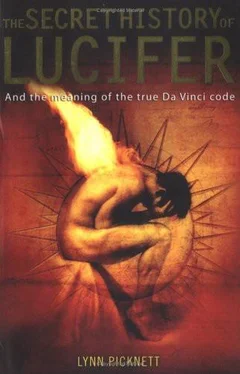On the other hand, another of Kramer's sources, Johannes Nider's Formaricus (1435), does associate outright diabolism with women's alleged natural sins - particularly that of insubordination, as evidenced in the rare occasions of their dressing in male clothing or carrying weapons. Pretending to be close to God was particularly singled out for male opprobrium. `It is presumption, deception and rebellion that are his targets.'89 In Kramer's hands, however, Nider is misquoted: women themselves become inherently evil, especially their propensity for carnality.
In a lather of the most embarrassingly obvious Freudian fear, Kramer emphasizes the anti-male crimes of women, such as their ability to make penises disappear (if only by means of illusion, the witches' glamour - an interesting addendum, rendering such an accusation open to an entirely subjective interpretation). Perhaps this primitive terror of impotence was behind the handbook's stress on the Inquisitors taking precautions against the witch's `evil eye', such as erecting a screen between themselves and the miscreant in the courtroom. (Although the authorities were assured many times that they alone had the power to withstand the witches deadly glance, few of the accusers felt particularly confident of this.) Another mode of protection was to wear a bag of salt consecrated on Palm Sunday; to avoid making eye contact with the witch, and to cross oneself as much as possible when in their jail. One Peter of Berne was careless, and plummeted down a flight of stone steps - clearly the result of a witch's enchantments, for he tortured her until she admitted it 90
Women who nag or usurp male authority were top of the Hammer's hit list, for it was assumed that they must be witches. At the same time, husbands had long been actively encouraged to abuse their wives to the last degree. Friar Cherubino's fifteenthcentury Rules of Marriage said to husbands:
Scold her sharply, bully and terrify her. And if this still doesn't work ... take up a stick and beat her soundly, for it is better to punish the body and correct the soul than to damage the soul and spare the body ... Then readily beat her, not in rage but out of charity and concern for her soul, so that beating will redound to your merit.9'
Saint Thomas Aquinas remarked that a wife is lower than a slave, for at least a slave can be freed, but `Woman is in subjection according to the law of nature, but a slave is not.'92 Presumably the `law of nature' means that as women are generally physically weaker than men, they should and must be bullied. Up until the late nineteenth-century it was legal for a British man to beat his wife as long as the instrument he used - a whip, cane or rod - was not thicker than his thumb, the original `rule of thumb'. As Walker says, `Wives had little help from the law; they were legally classified with minors and idiots, and were consigned to the custody of their husbands.'93 They were femmes couvertes, women whose personalities were legally `covered' by their husbands'. It was in this context that female rebels, children of Lucifer but not of Satan - however mild their actions might seem today - were hounded as witches.
Cunning harm
But another group were perceived as undermining the very fabric of godly society, and were therefore singled out for the harshest of treatment - midwives. Unfortunately, the very word comes from the Anglo-Saxon med-wyf, meaning `wise-woman' or `witch'. The Church's line on midwives was neatly summed up by Kramer and Sprenger: `No one does more cunning harm to the Catholic faith than midwives', explaining that they seize the newborn child and baptize him in the name of the Devil with a magical rite by the kitchen hearth." Unsurprisingly, Montague Summers agrees, but he is merely voicing a view that is alive and well, especially in twentyfirst-century American fundamentalist circles, for midwives were always associated not only with the mysteries of birth, but also procuring abortion. Kramer and Sprenger's statement, if modified to read: `No one does more harm to the Christian faith than abortionists', possesses a remarkably modem resonance.
In the ancient world, midwives were highly regarded: in Egypt they were ruled by Isis Hathor in her Sevenfold manifestation, who gave every child its seven souls. `An earthly midwife is a sort of fairy godmother, with a spiritual tie to each child she brings into the world'95 - the polar opposite of the demonized Christian midwife. In ancient Rome there were three types of midwife, all associated with the women's temple and linked to the Greek Horae, temple servants on earth, but midwives to the gods in heaven. The obstetrix assisted at the birth; the nutrix or `nurturer' taught the mysteries of nursing and encouraged the milk to flow, while the priestesses of Ceres, the ceraria, took charge of the religious rituals surrounding the birth. All were honoured members of society.
In Christendom, because women were deemed to be sacer or untouchable after giving birth, they were not allowed to enter church for forty days afterwards. Being unclean, only other women could deal with their physical and emotional needs at this time, so female midwives were essential to the wellbeing of both mother and child. But medieval clerics hated them, mainly because they echoed the era of goddess-worship, when women had power over their own lives. The detestation of midwives procuring abortions was not out of compassion for the unborn child, but because it implied a sort of empowered feminine freemasonry.
Women in general were always suspected of using enchantments in everyday life. The Dominican friar Johann Herolt thundered:
Most women belie their Catholic faith with charms and spells, after the fashion of Eve their first mother, who believed the devil speaking through the serpent rather than God himself ... Any woman by herself knows more of such superstitions and charms than a hundred men 96
Spells and potions were the only known cures before the sixteenth century - indeed, the clergy believed that the only way to heal the sick was through exorcism. Yet the great pioneering doctor Paracelsus admitted that witches had taught him everything he 17 However, whereas a male conjuror was knew about healing. permitted to heal by the use of the magical arts, women were put to death for doing the same.
Besides abortion, any form of contraception and the easing of birth-pangs was deemed anathema. In 1559 the Parliamentary Articles of Enquiry commanded local church officials to report the use of `charms, sorcery, enchantments, invocations, witchcrafts, soothsaying' or similar `especially in the time of women's travails.' (My emphasis). Unbelievably, in 1591, the Scottish noblewoman Eufame Macalyne was committed to the stake simply for seeking palliatives for the agonies of childbirth from a midwife. In 1554 midwives were expressly forbidden to use any means to alleviate childbed suffering other than prayers that `may stand with the laws and ordinances of the Catholic Church'. 8
Up until the twentieth century the view of the Christian patriarchy was that God had cursed Eve so that she and all women throughout history would give birth in pain, so anything that eased the agony went expressly against the will of God. When women died in their travails, the Church took this to be an example of God's `continuing judgement on the sex' 99
When the nineteenth-century James Simpson initiated the use of ether and chloroform in childbirth, there was a massive outcry across the Christian world. Clergymen denounced it as a `sinful denial of God's wishes',10° while Scottish ministers asserted that such pain-control would be `vitiating against the primal curse against woman'.101
Barbara Walker notes the words of a New England minister: `Chloroform is a decoy of Satan, apparently offering itself to bless women; but in the end it will harden society and rob God of the deep earnest cries which arise in time of trouble, for help.' 102 Walker comments briskly: `With the usual half-concealed sadism of patriarchal morality, he was really saying that female screams of pain gave God pleasure, and men must see to it that God was not deprived of this.' 103 (As we have seen, it was none other than Queen Victoria who set the seal of approval on the use of chloroform in childbirth, effectively silencing at least the British clergy once and for all.)
Читать дальше












